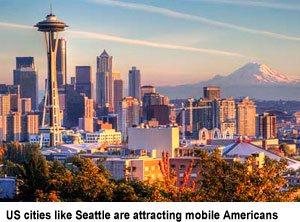
 Cities like New York are relying on foreign immigrats for growth  FRONT PAGE About us    2020 US Census - Counting Americans Police killings of Black Americans US mayors fight inequality American domestic migration Voting rights in the USA USA racial profiling US mayors fight against guns US gun contol in tatters US debates use of marijuana Vision for metro America Non-profits vital to urban USA Nonprofits versus US cities Catholic Church in urban USA Funding cities US poverty 2011 US affordable housing crisis Black American men Poverty in US cities US school reforms US urban inequality US clergy and local politics  Worldwide | Elections | North America | Latin America | Europe | Asia | Africa |                            |
A second tier of US metro areas
18 November 2013: America is known as a mobile society, and Americans move for many reasons: better jobs, better weather, lower housing costs, lower taxes, and so on. Since the end of World War II, the general movement of people within the United States has been from rural to urban areas. About 81 per cent of all people in the US now live in metropolitan areas comprised of a core city and surrounding suburbs. The trend to urbanization is national in scope, affecting every state and almost every region of the country. General population movements between regions have also been notable, of course, the most prominent being the shift from Rustbelt in the north to Sunbelt in the south. While the general population migrations receive most of the attention, a more particular shift appears to be occurring among metro areas. Approximately 15 second-tier metro areas have become ‘centers of gravity’, attracting people and capital from other metro areas. |
|
|||||||||||||||||||||||||||||||||
Of the 118 metro areas in which more people from other parts of the US moved in than moved out between 2000 and 2010, 15 metro areas captured 51 per cent of all the net growth: Atlanta, Austin, Charlotte, Dallas, Denver, Houston, Las Vegas, Orlando, Phoenix, Portland, Riverside, Sacramento, San Antonio, Seattle, and Tampa. The Census Bureau and the Internal Revenue Service record the distances people move. Most of the domestic migration in these 15 metro areas appears to come from outside the region, measured primarily as people moving in from a distance of 50 miles or more, that is, relocating from a different metro area. On the other hand, most of the growth in the other 103 metro areas that saw a net increase in domestic migration appears to result from people moving in from adjacent rural areas.
 Centers of gravity
Centers of gravityWhat appears to be happening is that a limited number of metros in the United States have become ‘centers of gravity’. They appear to grow, in large measure, at the expense of other metros, whose resources (especially talent, but also capital) ‘gravitate’ to these select metros. The ‘centers of gravity’ seem to have two main characteristics which trump virtually all others: first, a population greater than two million; and, second, relatively few burdens from industrial restructuring. Two million residents seems to be the minimum necessary for a US metro to sustain enough business clusters to establish a solid foothold in the global economy, if - and it’s a crucial if - that metro is not burdened by the entrenched poverty, vacant properties, aging infrastructure, and lower educational attainment that typically accompany the wrenching transformation from an industrial to a more knowledge-based economy.
Implications
What tends to gravitate to the relatively few metro centers of gravity primarily are the special, the unique, and the best quality. Census data find that the 15 metro centers of gravity are attracting not only most of the domestic migration, but also most of the best-educated people who move. The number of college graduates in each of these 15 metros increased at least 40 per cent between 2000 and 2010, far above the national average. Judging by the popular media, most are also reputed beacons of creativity, and Census data confirm that they attract disproportionate number of young adults and young families, as well as venture capital.
The momentum continues. The latest Census data, from 2010 to 2013, show the centers of gravity leading the nation in rates of population and job growth.
As resources gravitate from other metros to these centers of gravity, the other metropolitan areas that are at the two-million size but are restructuring, such as Cleveland and Detroit, may find themselves falling even farther behind in economic competitiveness despite their best efforts at regeneration. And most smaller metros may find it difficult to scale up their advantages to become centers of gravity themselves. Smaller metros always have some important advantages - a few high-value business clusters, great universities, lower costs of living, for example - but without enough fresh blood and fresh capital to add to their resource base (compared to the centers of gravity) all of the smaller metros end up advertising essentially the same basket of overall advantages. The smaller metros may likely find it tougher and tougher to differentiate themselves economically and otherwise not only from the centers of gravity, but also from one another.
Summary
The idea of metro centers of gravity is a hypothesis. More study is necessary to gauge its analytical strength and usefulness. But the data suggest it is an idea worth exploring.
The data suggest there is a two-tier system at the metro level in the United States, and there is little mobility between the tiers. A few smaller metros may become centers of gravity, but most can’t and won’t. The ‘centers of gravity’ are both a cause and a consequence of growth and will continue to slowly but inexorably pull away from other metro areas. A consequence may be that only the centers of gravity and America’s global cities, such as New York and Los Angeles, will realistically be able to control their destinies in the global economy. Most American metros will be relegated to reacting to economic change as best they can.
*Tony Favro’s latest book Hard Constants: Sustainability and the American City is now available free of charge from City Mayors. Please complete our order form to receive a pdf copy. Libraries of academic institutions may receive a hard copy. Order form
Follow @City_Mayors
